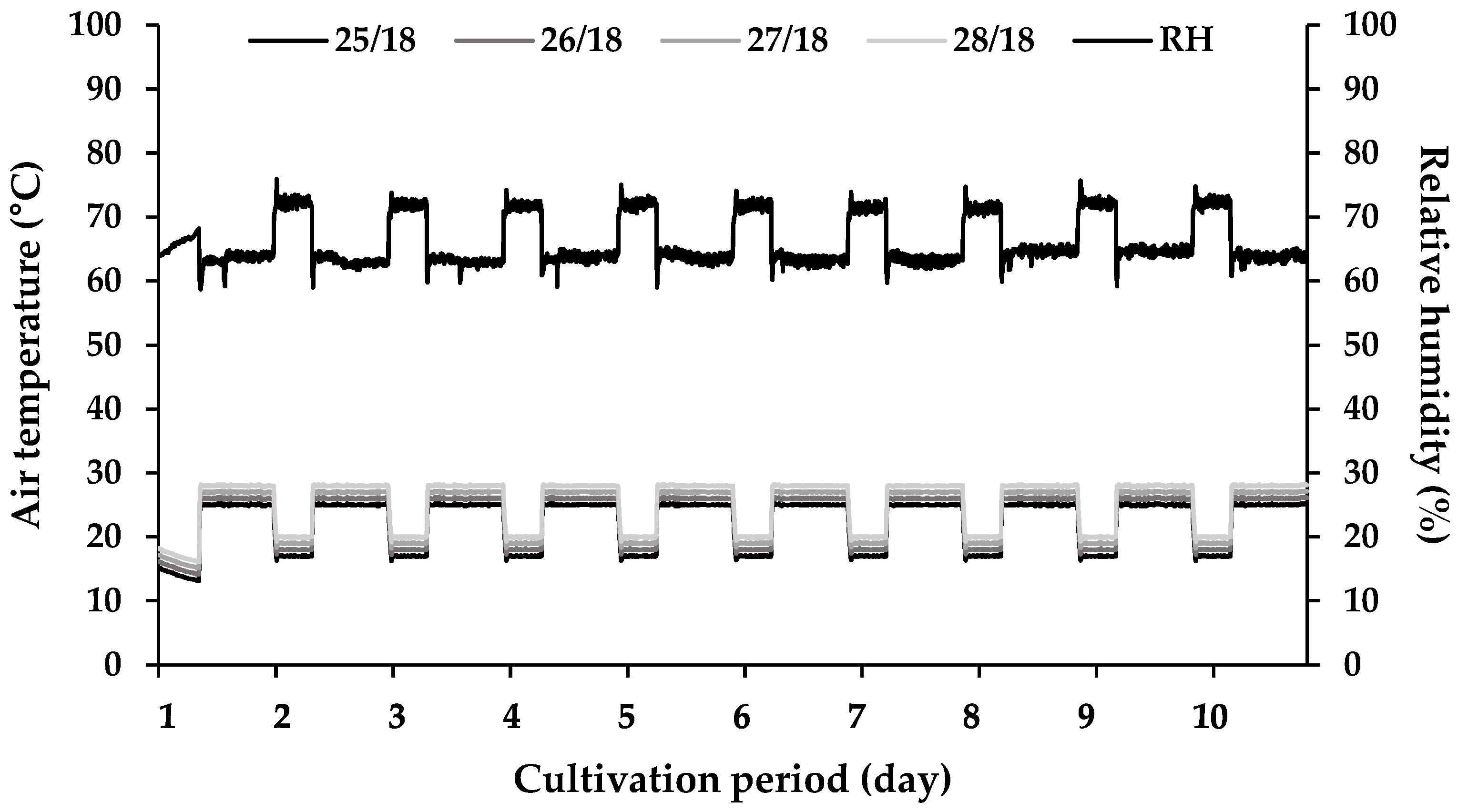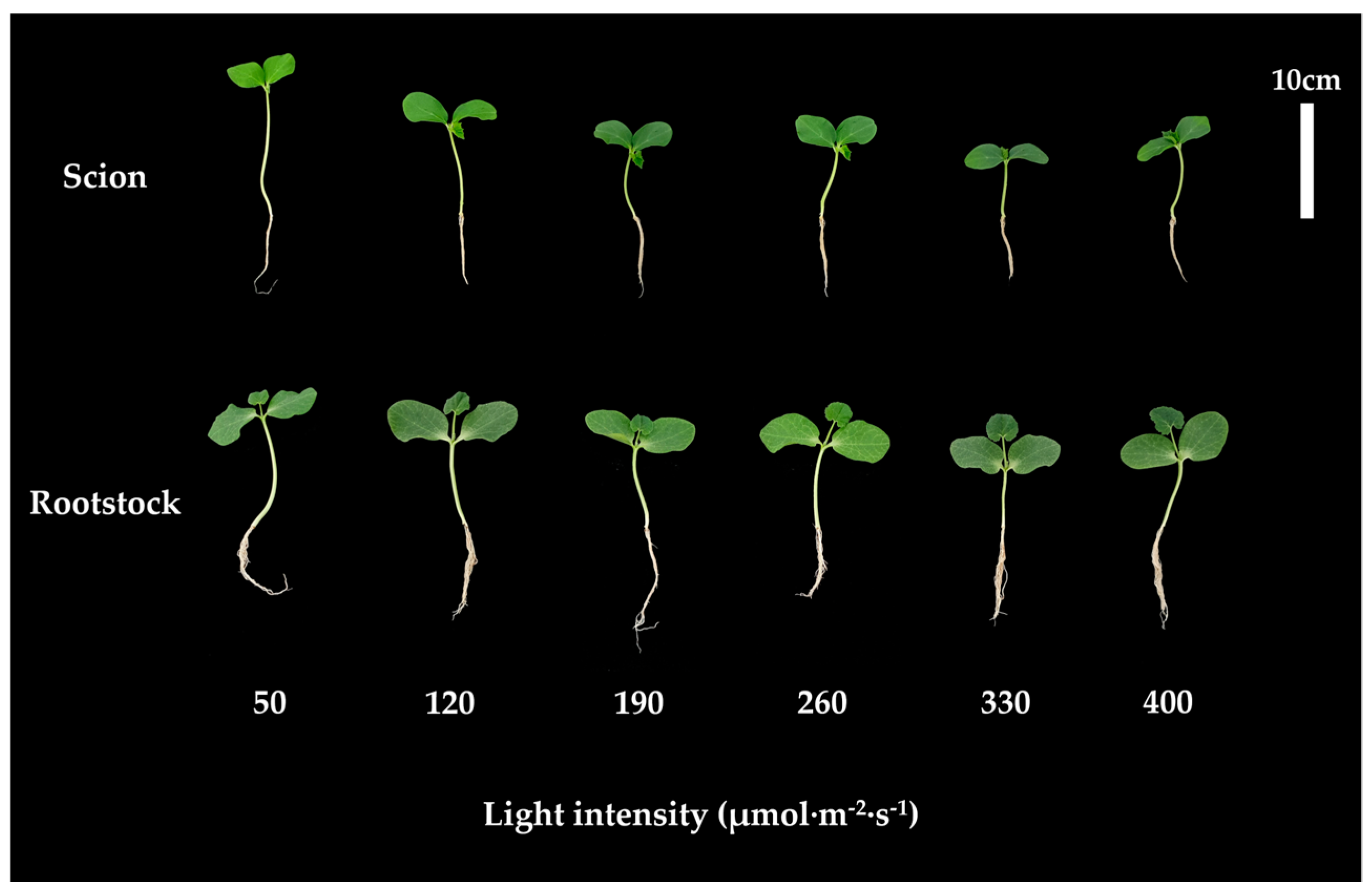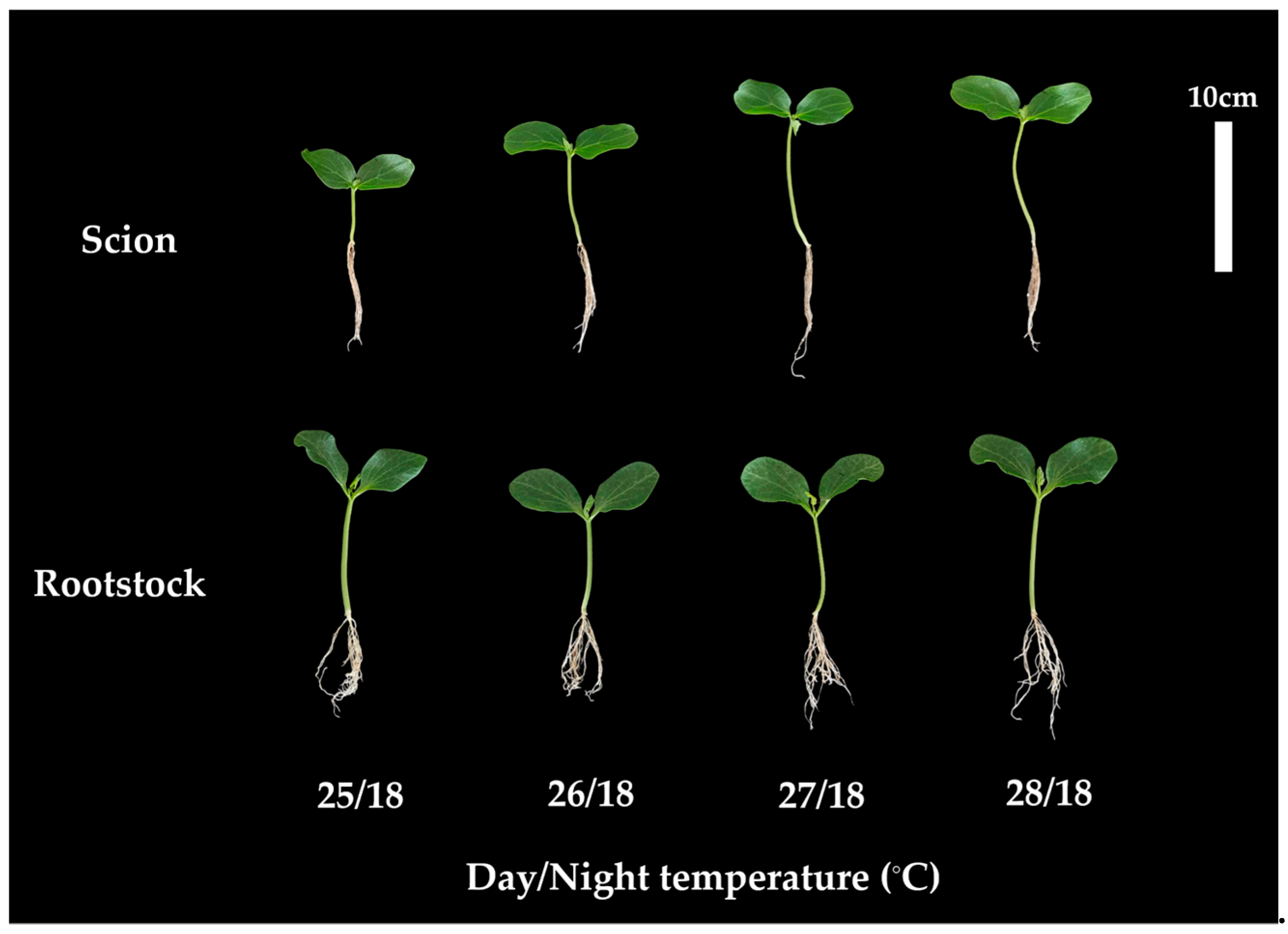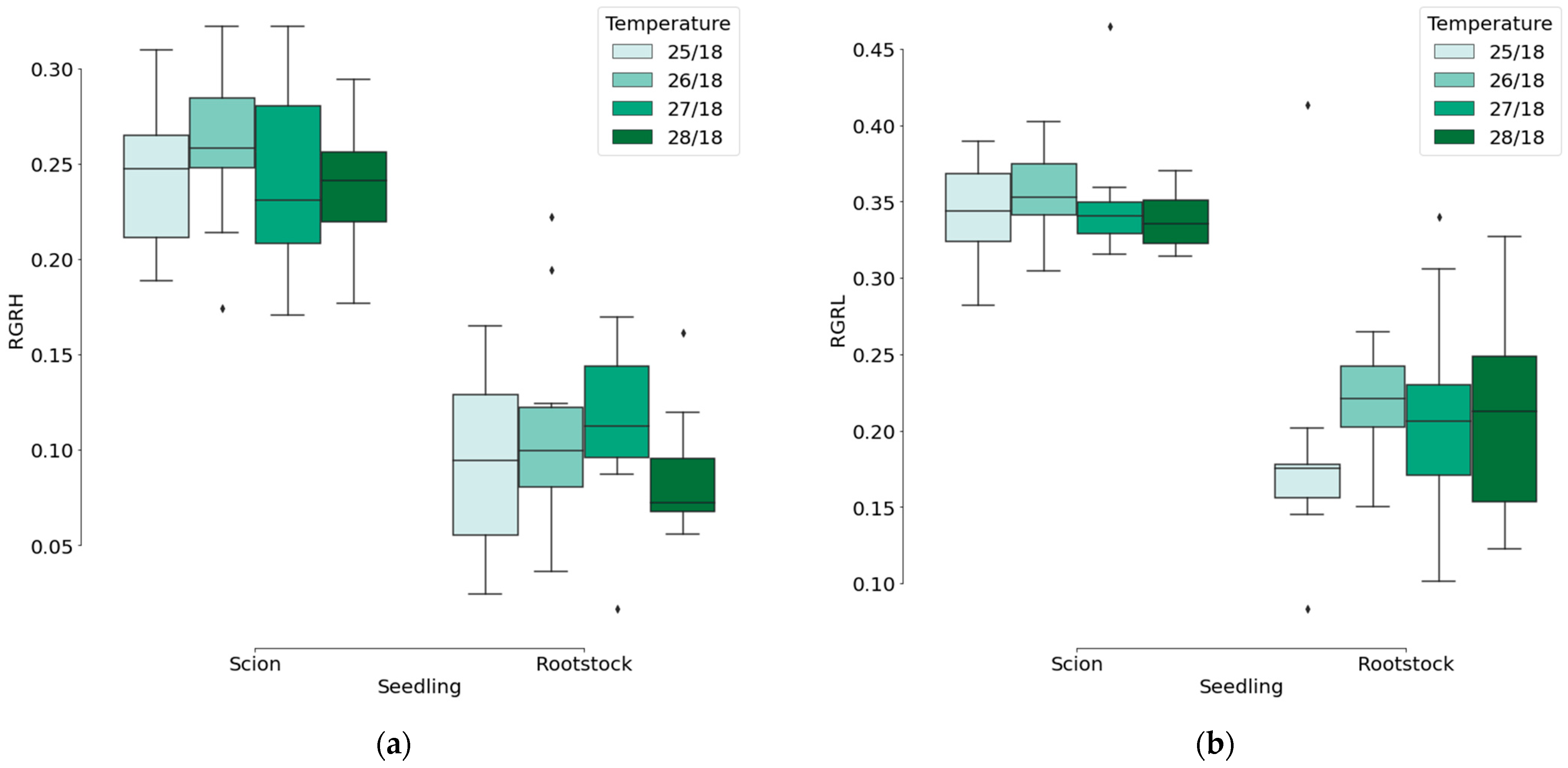Identification of Appropriate Light Intensity and Daytime Temperature for Cucumber (Cucumis sativus L.) Seedlings in a Plant Factory with Artificial Lighting for Use as Grafting Material
Abstract
:1. Introduction
2. Materials and Methods
2.1. Plant Materials and Growth Conditions
2.2. Plant Factory with Artificial Lighting (PFAL) Specifications
2.3. Light Treatments
2.4. Temperature Treatments
2.5. Growth Investigation
- H0 and H1: initial and final shoot fresh weight
- t1 − t0: growing period (days)
- H0 and H1: initial and final hypocotyl length
- t1 − t0: growing period (days)
- H0 and H1: initial and final leaf area
- t1 − t0: growing period (days)
2.6. Statistical Analysis
3. Results and Discussion
3.1. Cucumber Scions and Rootstocks in a PFAL: The Effect of Light Intensity Conditions
3.2. Cucumber Scions and Rootstocks in a PFAL: The Effect of Daytime Temperature Conditions
3.3. Correlation Matrix with Heatmap
4. Conclusions
Author Contributions
Funding
Institutional Review Board Statement
Informed Consent Statement
Data Availability Statement
Conflicts of Interest
References
- Lee, J.M.; Kubota, C.; Tsao, S.J.; Bie, Z.; Echevarria, P.H.; Morra, L.; Oda, M. Current status of vegetable grafting: Diffusion, grafting techniques, automation. Sci. Hortic. Amst. 2010, 127, 93–105. [Google Scholar] [CrossRef]
- Kim, H.M.; Hwang, S.J. Comparison of Pepper Grafting Efficiency by Grafting Robot. Prot. Hortic. Plant Fact. 2015, 24, 57–62. [Google Scholar] [CrossRef]
- Bisbis, M.; Gruda, N.; Blanke, M. Securing Horticulture in a Changing Climate—A Mini Review. Horticulturae 2019, 5, 56. [Google Scholar] [CrossRef] [Green Version]
- Kozai, T.; Niu, G. Role of the plant factory with artificial lighting (PFAL) in urban areas. In Plant Factory; Academic Press: Cambridge, MA, USA, 2020; pp. 7–34. [Google Scholar]
- Kozai, T. Sustainable plant factory: Closed plant production systems with artificial light for high resource use efficiencies and quality produce. In Proceedings of the International Symposium on Soilless Cultivation 1004, Shanghai, China, 22–25 May 2012; pp. 27–40. [Google Scholar]
- Kozai, T.; Niu, G. Plant factory as a resource-efficient closed plant production system. In Plant Factory; Elsevier: Amsterdam, The Netherlands, 2016; pp. 69–90. [Google Scholar]
- Park, S.W.; Kim, S.K.; Kwack, Y.; Chun, C. Simulation of the number of strawberry transplants produced by an autotrophic transplant production method in a plant factory with artificial lighting. Horticulturae 2020, 6, 63. [Google Scholar] [CrossRef]
- Zheng, J.; Ji, F.; He, D.; Niu, G. Effect of light intensity on rooting and growth of hydroponic strawberry runner plants in a LED plant factory. Agronomy 2019, 9, 875. [Google Scholar] [CrossRef] [Green Version]
- Hwang, H.; An, S.; Pham, M.D.; Cui, M.; Chun, C. The combined conditions of photoperiod, light intensity, and air temperature control the growth and development of tomato and red pepper seedlings in a closed transplant production system. Sustainability 2020, 12, 9939. [Google Scholar] [CrossRef]
- Bakker, J.; Van Uffelen, J. The effects of diurnal temperature regimes on growth and yield of glasshouse sweet pepper. Neth. J. Agric. Sci. 1988, 36, 201–208. [Google Scholar] [CrossRef]
- Janssen, L.H.; Wams, H.E.; van Hasselt, P.R. Temperature dependence of chlorophyll fluorescence induction and photosynthesis in tomato as affected by temperature and light conditions during growth. J. Plant Physiol. 1992, 139, 549–554. [Google Scholar] [CrossRef]
- Slack, G.; Hand, D. The effect of day and night temperatures on the growth, development and yield of glasshouse cucumbers. J. Hortic. Sci. 1983, 58, 567–573. [Google Scholar] [CrossRef]
- Yan, Z.; He, D.; Niu, G.; Zhai, H. Evaluation of growth and quality of hydroponic lettuce at harvest as affected by the light intensity, photoperiod and light quality at seedling stage. Sci. Hortic. Amst. 2019, 248, 138–144. [Google Scholar] [CrossRef]
- Kang, J.H.; KrishnaKumar, S.; Atulba, S.L.S.; Jeong, B.R.; Hwang, S.J. Light intensity and photoperiod influence the growth and development of hydroponically grown leaf lettuce in a closed-type plant factory system. Hortic. Environ. Biotechnol 2013, 54, 501–509. [Google Scholar] [CrossRef]
- Fan, X.-X.; Xu, Z.-G.; Liu, X.-Y.; Tang, C.-M.; Wang, L.-W.; Han, X.-l. Effects of light intensity on the growth and leaf development of young tomato plants grown under a combination of red and blue light. Sci. Hortic. Amst. 2013, 153, 50–55. [Google Scholar] [CrossRef]
- Park, S.; An, S.; Kwack, Y. Changes in Transpiration Rates and Growth of Cucumber and Tomato Scions and Rootstocks Grown Under Different Light Intensity Conditions in a Closed Transplant Production System. Prot. Hortic. Plant Fact. 2020, 29, 399–405. [Google Scholar] [CrossRef]
- Kwack, Y.; Park, S.W.; Chun, C. Growth and development of grafted cucumber transplants as affected by seedling ages of scions and rootstocks and light intensity during their cultivation in a closed production system. Hortic. Sci. Technol. 2014, 32, 600–606. [Google Scholar] [CrossRef] [Green Version]
- Yan, Z.; Wang, L.; Dai, J.; Liu, Y.; Lin, D.; Yang, Y. Morphological and Physiological Responses of Cucumber Seedlings to Different Combinations of Light Intensity and Photoperiod with the Same Daily Light Integral. HortScience 2021, 56, 1430–1438. [Google Scholar] [CrossRef]
- An, S.; Hwang, H.; Chun, C.; Jang, Y.; Lee, H.J.; Wi, S.H.; Yeo, K.-H.; Yu, I.-h.; Kwack, Y. Evaluation of air temperature, photoperiod and light intensity conditions to produce cucumber scions and rootstocks in a plant factory with artificial lighting. Horticulturae 2021, 7, 102. [Google Scholar] [CrossRef]
- Kwack, Y.; An, S. Changes in Growth of Watermelon Scions and Rootstocks Grown under Different Air Temperature and Light Intensity Conditions in a Plant Factory with Artificial Lighting. J. Bio-Environ. Control 2021, 30, 133–139. [Google Scholar] [CrossRef]
- Zheng, J.; Gan, P.; Ji, F.; He, D.; Yang, P. Growth and energy use efficiency of grafted tomato transplants as affected by LED light quality and photon flux density. Agriculture 2021, 11, 816. [Google Scholar] [CrossRef]
- Shim, K.S.; Cho, Y.B.; Lee, H.R. Smart Greenhouse Environment Management Guidelines, Rural Development Administration: Republic of Korea; Ministry of Land, Infrastructure, and Transport: Sejong, Republic of Korea, 2018; pp. 202–208. ISBN 979-11-290-1334-7. [Google Scholar]
- Dickson, A.; Leaf, A.L.; Hosner, J.F. Seedling quality—Soil fertility relationships of white spruce, and red and white pine in nurseries. For. Chron. 1960, 36, 237–241. [Google Scholar] [CrossRef] [Green Version]
- Bai, Y.; Shi, W.; Xing, X.; Wang, Y.; Jin, Y.; Zhang, L.; Song, Y.; Dong, L.; Liu, H. Study on tobacco vigorous seedling indexes model. Agric. Sci. China 2014, 6, 1086–1098. [Google Scholar]
- Jung, I.-S.; Kim, E.-J.; Kwak, J. Visualization Model for Security Threat Data in Smart Factory based on Heatmap. In Proceedings of the Korea Information Processing Society Conference, Jeju Island, Republic of Korea, 13–16 April 2021; pp. 284–287. [Google Scholar]
- Gómez, C.; Mitchell, C.A. Growth responses of tomato seedlings to different spectra of supplemental lighting. HortScience 2015, 50, 112–118. [Google Scholar] [CrossRef] [Green Version]
- Chia, P.-L.; Kubota, C. End-of-day far-red light quality and dose requirements for tomato rootstock hypocotyl elongation. HortScience 2010, 45, 1501–1506. [Google Scholar] [CrossRef] [Green Version]
- Garcia, C.; Lopez, R.G. Supplemental radiation quality influences cucumber, tomato, and pepper transplant growth and development. HortScience 2020, 55, 804–811. [Google Scholar] [CrossRef]
- Kozai, T. Resource use efficiency of closed plant production system with artificial light: Concept, estimation and application to plant factory. Proc. Jpn. Acad. Ser. B 2013, 89, 447–461. [Google Scholar] [CrossRef] [PubMed] [Green Version]
- Kozai, T.; Kubota, C.; Chun, C.; Afreen, F.; Ohyama, K. Necessity and concept of the closed transplant production system. In Proceedings of the International Symposium on Transplant Production in Closed System for Solving the Global Issues on Environmental Conservation, Food, Resources and Energy, Chiba, Japan, 28 February–2 March 2000; pp. 3–19. [Google Scholar]
- Kitaya, Y.; Shibuya, T.; Yoshida, M.; Kiyota, M. Effects of air velocity on photosynthesis of plant canopies under elevated CO2 levels in a plant culture system. Adv. Space Res. 2004, 34, 1466–1469. [Google Scholar] [CrossRef]
- Kwack, Y.; An, S.; Kim, S.K. Development of growth model for grafted hot pepper seedlings as affected by air temperature and light intensity. Sustainability 2021, 13, 5895. [Google Scholar] [CrossRef]







| Seedling | PPF (μmol·m−2·s−1) | Hypocotyl Length (cm) | Stem Diameter (mm) | Leaf Chlorophyll (SPAD) | Leaf Area (cm2) | Leaf Length (cm) | Leaf Width (cm) | DQI z | CP (mg·cm−1) | SHI (g) |
|---|---|---|---|---|---|---|---|---|---|---|
| Scion | 50 | 10.6 ± 1.1 a y | 1.2 ± 0.2 c | 37.6 ± 2.6 c | 15.3 ± 2.5 c | 2.4 ± 0.4 c | 2.0 ± 0.3 ab | 2.3 ± 0.6 e | 3.9 ± 0.6 d | 9.6 ± 2.5 e |
| 120 | 9.2 ± 1.1 b | 1.5 ± 0.1 b | 37.9 ± 1.8 c | 17.8 ± 2.1 b | 2.7 ± 0.4 bc | 2.2 ± 0.2 a | 3.4 ± 0.7 d | 5.3 ± 1.0 c | 14.1 ± 2.8 d | |
| 190 | 6.9 ± 0.7 cd | 1.5 ± 0.1 b | 44.5 ± 2.6 b | 18.4 ± 1.5 b | 2.7 ± 0.3 abc | 2.3 ± 0.2 a | 5.2 ± 0.9 c | 8.4 ± 0.8 b | 24.6 ± 3.4 c | |
| 260 | 7.7 ± 1.6 c | 1.5 ± 0.2 b | 45.7 ± 2.5 b | 20.6 ± 2.0 a | 3.2 ± 0.4 a | 2.2 ± 0.2 a | 4.9 ± 0.7 c | 8.5 ± 1.4 b | 20.9 ± 3.5 c | |
| 330 | 6.0 ± 1.1 d | 1.7 ± 0.1 a | 50.1 ± 2.8 a | 17.2 ± 1.0 b | 2.9 ± 0.3 ab | 1.9 ± 0.3 b | 7.2 ± 1.4 b | 12.2 ± 1.9 a | 32.3 ± 6.4 b | |
| 400 | 6.4 ± 0.9 d | 1.8 ± 0.1 a | 48.6 ± 3.3 a | 17.3 ± 2.3 b | 3.1 ± 0.5 ab | 1.8 ± 0.1 b | 8.8 ± 1.5 a | 12.2 ± 2.1 a | 36.5 ± 6.1 a | |
| Rootstock | 50 | 11.9 ± 1.2 a | 2.7 ± 0.3 a | 59.7 ± 3.2 a | 43.9 ± 5.3 c | 4.8 ± 0.8 c | 3.1 ± 0.3 ab | 13.3 ± 2.3 e | 16.1 ± 3.1 d | 64.3 ± 14.5 c |
| 120 | 9.5 ± 1.3 b | 2.2 ± 0.4 b | 58.5 ± 5.0 a | 51.8 ± 7.7 ab | 5.4 ± 0.6 b | 3.2 ± 0.3 a | 15.6 ± 3.4 de | 22.0 ± 4.5 c | 74.5 ± 9.7 c | |
| 190 | 7.7 ± 1.1 c | 2.6 ± 0.2 a | 52.1 ± 4.8 b | 54.7 ± 7.5 a | 5.9 ± 0.7 ab | 3.1 ± 0.3 ab | 19.6 ± 3.7 bc | 27.8 ± 4.8 b | 100.1 ± 16.2 b | |
| 260 | 7.7 ± 1.2 c | 2.6 ± 0.2 a | 56.6 ± 7.3 ab | 48.3 ± 2.4 bc | 5.3 ± 0.3 bc | 3.0 ± 0.1 ab | 17.5 ± 2.5 cd | 30.3 ± 4.5 b | 100.7 ± 12.6 b | |
| 330 | 5.9 ± 1.0 d | 2.7 ± 0.2 a | 59.3 ± 6.0 a | 50.1 ± 4.0 ab | 5.5 ± 0.4 b | 2.9 ± 1.8 ab | 23.6 ± 2.8 a | 37.9 ± 6.6 a | 131.9 ± 20.1 a | |
| 400 | 6.8 ± 1.0 cd | 2.7 ± 0.2 a | 57.1 ± 4.2 a | 54.0 ± 4.2 a | 6.3 ± 0.6 a | 2.8 ± 1.7 b | 21.3 ± 2.5 ab | 35.6 ± 5.3 a | 122.1 ± 11.1 a | |
| Significance x | ||||||||||
| Seedling (A) | * | *** | *** | *** | *** | *** | *** | *** | *** | |
| Light intensity (B) | *** | *** | *** | *** | *** | ** | *** | *** | *** | |
| Interaction (A × B) | NS | *** | *** | ** | ** | NS | ** | *** | *** | |
| Seedling | PPF (μmol·m−2·s−1) | Fresh Weight (g) | Dry Weight (g) | ||||
|---|---|---|---|---|---|---|---|
| Leaf | Stem | Root | Leaf | Stem | Root | ||
| Scion | 50 | 0.42 ± 0.06 d z | 0.43 ± 0.07 a | 0.11 ± 0.02 b | 0.025 ± 0.005 c | 0.011 ± 0.004 b | 0.004 ± 0.002 d |
| 120 | 0.49 ± 0.05 c | 0.36 ± 0.12 abc | 0.13 ± 0.03 b | 0.029 ± 0.006 c | 0.013 ± 0.004 ab | 0.006 ± 0.001 d | |
| 190 | 0.57 ± 0.07 b | 0.34 ± 0.05 bc | 0.22 ± 0.03 a | 0.039 ± 0.006 b | 0.011 ± 0.003 b | 0.008 ± 0.002 c | |
| 260 | 0.67 ± 0.07 a | 0.40 ± 0.11 ab | 0.22 ± 0.05 a | 0.044 ± 0.007 ab | 0.013 ± 0.003 ab | 0.007 ± 0.001 c | |
| 330 | 0.63 ± 0.06 a | 0.31 ± 0.06 c | 0.23 ± 0.04 a | 0.049 ± 0.005 a | 0.013 ± 0.003 ab | 0.010 ± 0.002 b | |
| 400 | 0.65 ± 0.05 a | 0.34 ± 0.05 bc | 0.25 ± 0.05 a | 0.049 ± 0.010 a | 0.015 ± 0.002 a | 0.013 ± 0.002 a | |
| Rootstock | 50 | 2.31 ± 0.49 b | 1.32 ± 0.19 a | 0.58 ± 0.07 a | 0.128 ± 0.026 c | 0.043 ± 0.003 a | 0.018 ± 0.003 c |
| 120 | 2.57 ± 0.24 ab | 1.12 ± 0.13 b | 0.57 ± 0.12 a | 0.143 ± 0.022 bc | 0.041 ± 0.006 ab | 0.021 ± 0.004 bc | |
| 190 | 2.68 ± 0.39 a | 0.95 ± 0.23 c | 0.62 ± 0.17 a | 0.146 ± 0.024 bc | 0.040 ± 0.011 ab | 0.024 ± 0.005 ab | |
| 260 | 2.45 ± 0.18 ab | 0.89 ± 0.17 cd | 0.56 ± 0.11 a | 0.168 ± 0.008 a | 0.039 ± 0.006 ab | 0.021 ± 0.004 bc | |
| 330 | 2.57 ± 0.30 ab | 0.68 ± 0.16 e | 0.67 ± 0.01 a | 0.158 ± 0.020 ab | 0.035 ± 0.006 b | 0.027 ± 0.004 a | |
| 400 | 2.58 ± 0.26 ab | 0.77 ± 0.13 de | 0.60 ± 0.09 a | 0.176 ± 0.013 a | 0.036 ± 0.005 b | 0.025 ± 0.004 a | |
| Significance y | |||||||
| Seedling (A) | *** | *** | *** | *** | *** | *** | |
| Light intensity (B) | ** | *** | ** | *** | NS | *** | |
| Interaction (A × B) | NS | *** | NS | NS | * | NS | |
| Seedling | Day/Night Temperature (°C) | Hypocotyl Length (cm) | Stem Diameter (mm) | Leaf Chlorophyll (SPAD) | Leaf Area (cm2) | Leaf Length (cm) | Leaf Width (cm) | DQI z | CP (mg·cm−1) | SHI (g) |
|---|---|---|---|---|---|---|---|---|---|---|
| Scion | 25/18 | 6.5 ± 0.8 c y | 1.6 ± 0.3 a | 55.3 ± 4.5 a | 20.0 ± 1.6 b | 3.0 ± 0.4 a | 1.8 ± 0.3 a | 5.0 ± 1.4 ab | 8.1 ± 1.2 a | 21.7 ± 5.3 ab |
| 26/18 | 7.9 ± 1.3 b | 1.6 ± 0.4 a | 48.1 ± 3.1 c | 21.9 ± 1.4 a | 3.2 ± 0.2 a | 1.9 ± 0.2 a | 5.3 ± 1.5 a | 8.1 ± 1.8 a | 23.6 ± 5.7 a | |
| 27/18 | 8.2 ± 1.8 ab | 1.6 ± 0.3 a | 50.8 ± 4.8 bc | 21.1 ± 1.4 ab | 3.0 ± 0.3 a | 2.0 ± 0.2 a | 3.7 ± 2.4 ab | 6.5 ± 1.9 b | 16.6 ± 8.7 b | |
| 28/18 | 9.3 ± 1.3 a | 1.7 ± 0.2 a | 52.3 ± 4.8 ab | 21.0 ± 1.8 ab | 3.0 ± 0.3a | 1.9 ± 0.3a | 3.4 ± 2.1 b | 5.2 ± 1.1 b | 15.7 ± 8.3 b | |
| Rootstock | 25/18 | 8.1 ± 1.8 a | 3.6 ± 0.5 a | 69.2 ± 2.8 a | 33.7 ± 4.5 a | 5.9 ± 1.8 a | 2.9 ± 0.5 a | 22.3 ± 5.5 a | 23.9 ± 5.9 a | 116.8 ± 30.6 ab |
| 26/18 | 7.2 ± 1.1 a | 3.8 ± 0.4 a | 64.2 ± 4.0 b | 34.5 ± 3.1 a | 5.8 ± 1.1 a | 2.9 ± 0.2 a | 21.5 ± 2.4 a | 27.4 ± 5.3 a | 131.3 ± 23.8 a | |
| 27/18 | 8.1 ± 1.2 a | 3.7 ± 0.3 a | 64.2 ± 4.5 b | 33.8 ± 6.6 a | 6.2 ± 1.4 a | 2.7 ± 0.4 a | 19.2 ± 5.0 a | 25.5 ± 8.8 a | 120.1 ± 37.5 ab | |
| 28/18 | 8.4 ± 1.2 a | 3.3 ± 0.4 a | 68.6 ± 6.5 ab | 25.5 ± 4.7 b | 5.1 ± 1.8 a | 2.5 ± 0.4 a | 19.1 ± 3.8 a | 21.8 ± 5.3 a | 99.6 ± 24.8 b | |
| Significance x | ||||||||||
| Seedling (A) | NS | *** | *** | *** | *** | *** | *** | *** | *** | |
| Day/Night temperature (B) | ** | NS | *** | *** | * | NS | * | * | * | |
| Interaction (A × B) | * | NS | NS | ** | * | NS | NS | NS | NS | |
| Seedling | Day/Night Temperature (℃) | Root Length (cm) | Root Fresh Weight (g) | Root Surface (cm2) | Root Average Diameter (mm) | No. of Root Tips | ||||
|---|---|---|---|---|---|---|---|---|---|---|
| >0.5 mm | 0.5~1.0 mm | 1.0~1.5 mm | <1.5 mm | Total | ||||||
| Scion | 25/18 | 80.6 ± 14.5 a z | 12.7 ± 1.5 a | 2.6 ± 0.5 a | 0.9 ± 0.5 a | 96.9 ± 15.3 a | 0.29 ± 0.11 a | 3.5 ± 0.4 a | 0.10 ± 0.01 a | 1037.7 ± 304.6 a |
| 26/18 | 58.2 ± 16.4 b | 12.4 ± 2.4 a | 3.0 ± 0.6 a | 1.2 ± 0.2 a | 74.9 ± 18.9 b | 0.23 ± 0.08 ab | 3.1 ± 0.6 a | 0.10 ± 0.02 a | 625.6 ± 287.8 bc | |
| 27/18 | 52.7 ± 13.2 b | 9.8 ± 1.8 b | 1.9 ± 0.5 b | 1.0 ± 0.6 a | 65.6 ± 14.3 bc | 0.17 ± 0.12 b | 2.5 ± 0.4 b | 0.08 ± 0.01 b | 722.6 ± 241.6 b | |
| 28/18 | 44.9 ± 15.3 b | 8.3 ± 2.0 b | 1.9 ± 0.5 b | 0.8 ± 0.5 a | 56.1 ± 16.3 c | 0.18 ± 0.15 ab | 2.2 ± 0.5 b | 0.07 ± 0.01 b | 414.8 ± 157.5 c | |
| Rootstock | 25/18 | 117.2 ± 28.8 a | 28.1 ± 9.2 a | 6.9 ± 4.0 a | 3.7 ± 2.7 a | 156.0 ± 41.2 a | 0.68 ± 0.23 b | 6.7 ± 2.3 a | 0.23 ± 0.04 a | 1676.0 ± 437.4 a |
| 26/18 | 127.0 ± 18.5 a | 24.8 ± 6.8 a | 6.9 ± 3.8 a | 4.7 ± 2.8 a | 163.5 ± 27.2 a | 0.88 ± 0.12 a | 7.0 ± 2.0 a | 0.24 ± 0.03 a | 1746.6 ± 299.2 a | |
| 27/18 | 99.0 ± 39.9 a | 28.8 ± 7.4 a | 6.1 ± 2.3 a | 7.9 ± 2.5 a | 138.1 ± 46.4 a | 0.73 ± 0.15 b | 6.6 ± 2.6 a | 0.25 ± 0.04 a | 1133.2 ± 450.8 b | |
| 28/18 | 102.8 ± 31.4 a | 31.6 ± 6.4 a | 7.5 ± 3.4 a | 9.6 ± 3.8 a | 146.3 ± 36.1 a | 0.71 ± 0.13 b | 8.3 ± 4.6 a | 0.40 ± 0.12 a | 1158.6 ± 357.4 b | |
| Significance y | ||||||||||
| Seedling (A) | *** | *** | *** | *** | *** | *** | *** | *** | *** | |
| Day/Night temperature (B) | ** | NS | NS | NS | * | ** | NS | NS | *** | |
| Interaction (A × B) | NS | * | NS | NS | NS | NS | NS | NS | ** | |
Disclaimer/Publisher’s Note: The statements, opinions and data contained in all publications are solely those of the individual author(s) and contributor(s) and not of MDPI and/or the editor(s). MDPI and/or the editor(s) disclaim responsibility for any injury to people or property resulting from any ideas, methods, instructions or products referred to in the content. |
© 2023 by the authors. Licensee MDPI, Basel, Switzerland. This article is an open access article distributed under the terms and conditions of the Creative Commons Attribution (CC BY) license (https://creativecommons.org/licenses/by/4.0/).
Share and Cite
Yang, H.-C.; Kim, Y.-H.; Byun, H.-J.; Choi, I.-L.; Vu, N.-T.; Kim, D.-H.; Yoon, H.-S.; Jang, D.-C. Identification of Appropriate Light Intensity and Daytime Temperature for Cucumber (Cucumis sativus L.) Seedlings in a Plant Factory with Artificial Lighting for Use as Grafting Material. Sustainability 2023, 15, 4481. https://doi.org/10.3390/su15054481
Yang H-C, Kim Y-H, Byun H-J, Choi I-L, Vu N-T, Kim D-H, Yoon H-S, Jang D-C. Identification of Appropriate Light Intensity and Daytime Temperature for Cucumber (Cucumis sativus L.) Seedlings in a Plant Factory with Artificial Lighting for Use as Grafting Material. Sustainability. 2023; 15(5):4481. https://doi.org/10.3390/su15054481
Chicago/Turabian StyleYang, Hwi-Chan, Young-Ho Kim, Hyo-Jeung Byun, In-Lee Choi, Ngoc-Thang Vu, Dea-Hoon Kim, Hyuk-Sung Yoon, and Dong-Cheol Jang. 2023. "Identification of Appropriate Light Intensity and Daytime Temperature for Cucumber (Cucumis sativus L.) Seedlings in a Plant Factory with Artificial Lighting for Use as Grafting Material" Sustainability 15, no. 5: 4481. https://doi.org/10.3390/su15054481
APA StyleYang, H.-C., Kim, Y.-H., Byun, H.-J., Choi, I.-L., Vu, N.-T., Kim, D.-H., Yoon, H.-S., & Jang, D.-C. (2023). Identification of Appropriate Light Intensity and Daytime Temperature for Cucumber (Cucumis sativus L.) Seedlings in a Plant Factory with Artificial Lighting for Use as Grafting Material. Sustainability, 15(5), 4481. https://doi.org/10.3390/su15054481







